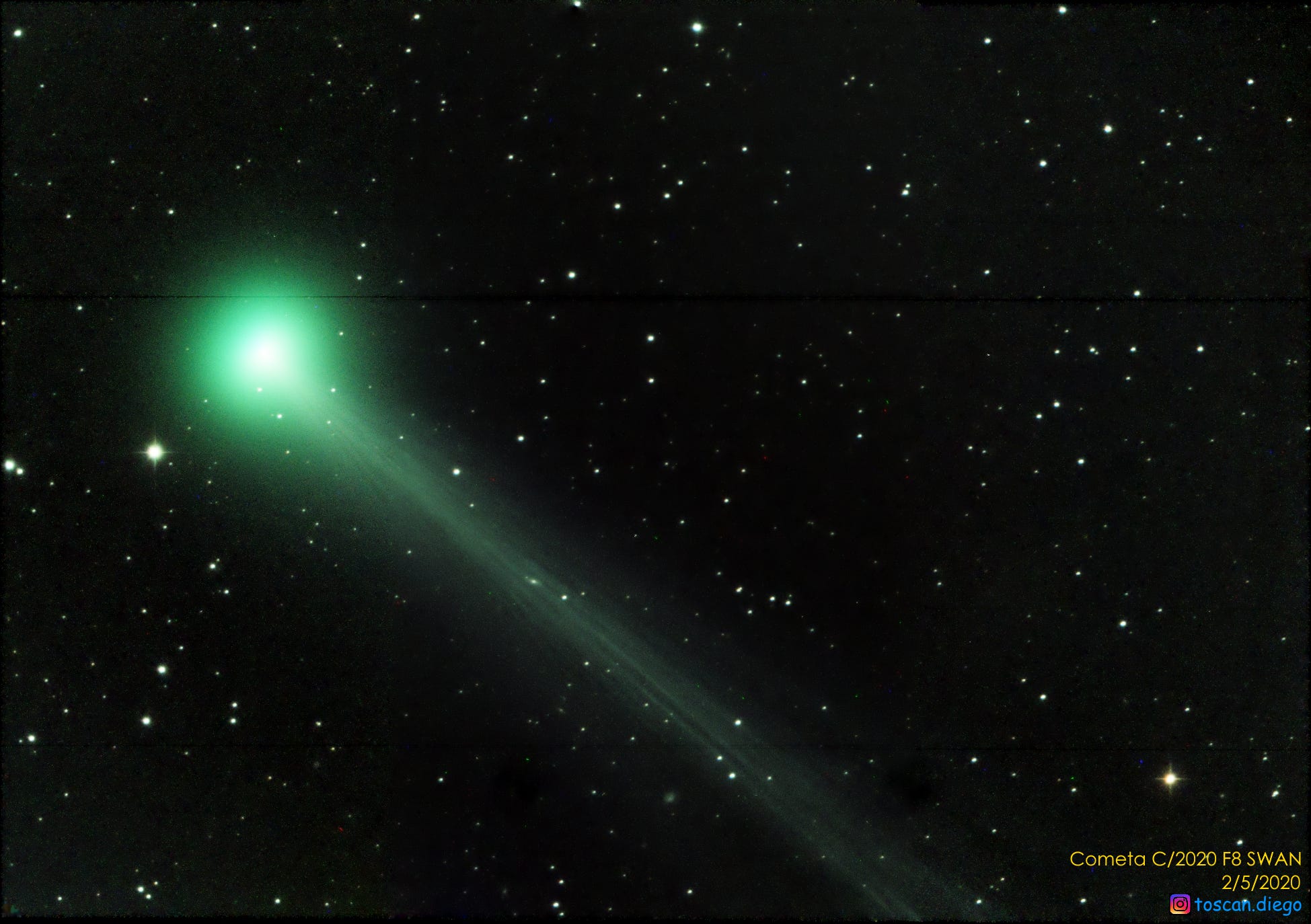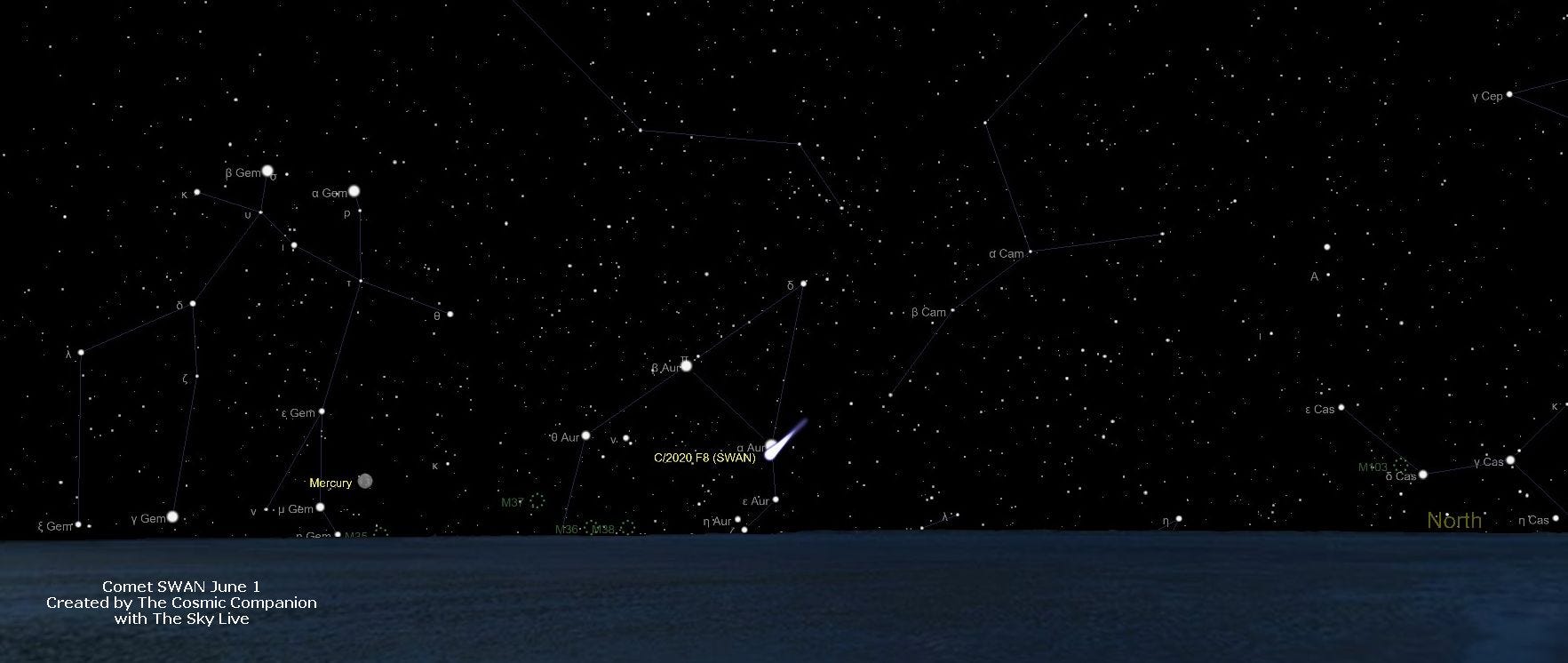Night skies in late May and early June may be graced by the sight of a magnificent swan. But, this is no bird — it is a visitor from the distant reaches of the Solar System. C/2020 F8 (SWAN) (or Comet SWAN) is, just now, starting to be visible to viewers under dark skies without the use of binoculars or a telescope. Oddly, this icy remnant from the outer solar system was discovered by an amateur scientist, looking in data from an instrument not meant to find comets. Read: [Hubble Space Telescope snaps amazing images of Comet Atlas shattering]
It takes SWAN to know SWAN
The Solar Wind ANisotropies (SWAN) instrument aboard SOHO, normally used to study the region of space surrounding the Sun, recorded the first sight of the comet which now bears its name. “SWAN captures images in ultraviolet light, including a specific ultraviolet wavelength called Lyman alpha. This is a wavelength that is characteristically emitted by hydrogen atoms… [I]t has become an effective discoverer of comets too because comets are also sources of hydrogen,” the European Space Agency reports. As the comet races toward the inner solar system, the icy body is starting to heat. As it does, vapor rises from the nucleus of the comet, and is pushed back by pressure from the Sun, forming a tail. Already, Comet SWAN is converting 1.3 tonnes (1.5 tons) of material in its frozen core into an ever-growing tail each second. The hydrogen within this water then becomes an easy target for the eyes of the SOHO observatory. In addition, as the water (H2O) breaks down, some of the molecules rearrange, forming hydrogen atoms and hydroxyls (containing one hydrogen and one oxygen atoms each). These hydroxyls shine brightly as seen by the SWAN instrument. Each day, SOHO maps nearly the entire sky, including data from countless stars. Researchers digitally removed “fixed” stars from the observations, showing just objects, like comets, that moved across the seemingly-fixed background. This is the 3,962nd comet discovered using SOHO, and the 12th such body spotted in data from the SWAN instrument. Mattiazzo has now scored eight victories. “Almost all of the nearly 4,000 discoveries have been made using data from SOHO’s coronagraph, an instrument that blocks out the Sun’s bright face using a metal disk to reveal the comparatively faint outer atmosphere, the corona,” the Comet Observation Database reports. Comet SWAN made its closest approach to Earth on May 13, when it came within 85 million kilometers (53 million miles) of our home planet. — Henry VI, William Shakespeare “Comet SWAN’s closest approach to the Sun, called perihelion, will happen on May 27,” NASA explains. Following this close approach to the Sun (at a distance of roughly 65 million kilometers from the Sun — less than half that of Earth), Comet SWAN will begin its journey back out to the far reaches of the Solar System.
Being an amateur cometologist
Comets can be seen from Earth for days to weeks, so there is time to enjoy the view during walks, or while spending time in your backyard. Binoculars would be a perfect tool to help explore the comet. Anything is better than nothing, but ones with wide lenses (like 10×50) are ideal. The exact place it will be seen in the sky will depend on the location of the viewer. However, from much of the northern hemisphere, it will be seen low on the northwestern horizon, in the hours after sunset. Nearly all comets discovered from SOHO observations were found by amateurs. Most of those were found examining findings from the Large Angle and Spectrometric Coronagraph Experiment (LASCO). Images from SOHO are available for citizen scientists to make their own discoveries, perhaps even finding their own comet. “Comets are fragile objects, and can often break apart as they approach the Sun. In late April, the much anticipated Comet ATLAS suffered this fate, breaking into at least 30 fragments. Comet SWAN is now entering the ‘danger zone’ and will reach its closest point to the Sun on 27 May — at this time, the solar heating will be at its maximum,” ESA explains. Whether Comet SWAN delights or disappoints remains to be seen. All we can do is look to the skies and hope to be graced by the sight of a graceful green SWAN. This article was originally published on The Cosmic Companion by James Maynard, founder and publisher of The Cosmic Companion. He is a New England native turned desert rat in Tucson, where he lives with his lovely wife, Nicole, and Max the Cat. You can read this original piece here. Astronomy News with The Cosmic Companion is also available as a weekly podcast, carried on all major podcast providers. Tune in every Tuesday for updates on the latest astronomy news, and interviews with astronomers and other researchers working to uncover the nature of the Universe.


